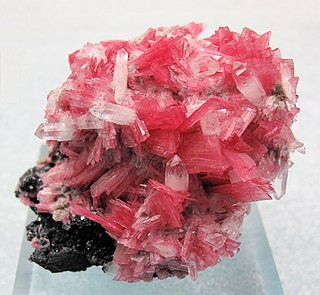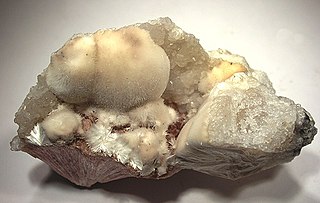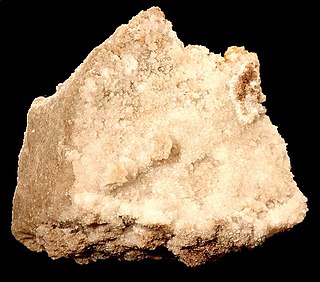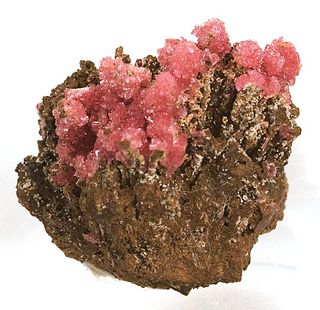
Erythrite or red cobalt is a secondary hydrated cobalt arsenate mineral with the formula Co
3(AsO
4)
2•8H
2O. Erythrite and annabergite, chemical formula Ni
3(AsO
4)
2•8H
2O, or nickel arsenate form a complete series with the general formula (Co,Ni)
3(AsO
4)
2•8H
2O.

Rhodonite is a manganese inosilicate, with the formula (Mn, Fe, Mg, Ca)SiO3, and member of the pyroxenoid group of minerals, crystallizing in the triclinic system. It commonly occurs as cleavable to compact masses with a rose-red color (its name comes from Ancient Greek ῥόδον (rhódon) 'rose'), often tending to brown due to surface oxidation. The rose-red hue is caused by the manganese cation (Mn2+).

Annabergite is an arsenate mineral consisting of a hydrous nickel arsenate, Ni3(AsO4)2·8H2O, crystallizing in the monoclinic system and isomorphous with vivianite and erythrite. Crystals are minute and capillary and rarely met with, the mineral occurring usually as soft earthy masses and encrustations. A fine apple-green color is its characteristic feature. It was long known (since 1758) under the name nickel bloom; the name annabergite was proposed by H. J. Brooke and W H. Miller in 1852, from Annaberg in Saxony, one of the localities of the mineral. It occurs with ores of nickel, of which it is a product of alteration. A variety, from Creetown in Kirkcudbrightshire, in which a portion of the nickel is replaced by calcium, has been called dudgeonite, after P. Dudgeon, who found it.

Austinite is a member of the adelite-descloizite group, adelite subgroup, the zinc (Zn) end member of the copper-Zn series with conichalcite. It is the zinc analogue of cobaltaustinite and nickelaustinite. At one time “brickerite” was thought to be a different species, but it is now considered to be identical to austinite. Austinite is named in honour of Austin Flint Rogers (1877–1957), American mineralogist from Stanford University, California, US.

Whewellite is a mineral, hydrated calcium oxalate, formula Ca C2O4·H2O. Because of its organic content it is thought to have an indirect biological origin; this hypothesis is supported by its presence in coal and sedimentary nodules. However, it has also been found in hydrothermal deposits where a biological source appears improbable. For this reason, it may be classed as a true mineral.

Brushite is a phosphate mineral with the chemical formula CaHPO4·2H2O. Crystals of the pure compound belong to the monoclinic space group C2/c and are colorless. It is the phosphate analogue of the arsenate pharmacolite.

Xonotlite, or eakleite, is a mineral of general formula Ca6Si6O17(OH)2 named by the German mineralogist Karl Friedrich August Rammelsberg in 1866. The name originates from its discovery locality, Tetela de Xonotla, Puebla, Mexico. Although it was discovered in 1866, it was first described in 1959. It is approved by the IMA, but it is a grandfathered species, meaning the name supposedly represents a valid species til this day.
Geigerite is a mineral, a complex hydrous manganese arsenate with formula: Mn5(AsO3OH)2(AsO4)2·10H2O. It forms triclinic pinacoidal, vitreous, colorless to red to brown crystals. It has a Mohs hardness of 3 and a specific gravity of 3.05.

Pigeonite is a mineral in the clinopyroxene subgroup of the pyroxene group. It has a general formula of (Ca,Mg,Fe)(Mg,Fe)Si2O6. The calcium cation fraction can vary from 5% to 25%, with iron and magnesium making up the rest of the cations.

Szomolnokite (Fe2+SO4·H2O) is a monoclinic iron sulfate mineral forming a complete solid solution with magnesium end-member kieserite (MgSO4·H2O). In 1877 szomolnokite's name was derived by Joseph Krenner from its type locality of oxidized sulfide ore containing iron in Szomolnok, Slovakia (Hungary at the time).

Åkermanite (Ca2Mg[Si2O7]) is a melilite mineral of the sorosilicate group, containing calcium, magnesium, silicon, and oxygen. It is a product of contact metamorphism of siliceous limestones and dolomites, and rocks of sanidinite facies. Sanidinite facies represent the highest conditions of temperature of contact metamorphism and are characterized by the absence of hydrous minerals. It has a density of 2.944 g/cm3. Åkermanite ranks a 5 or 6 on the Mohs scale of mineral hardness, and can be found gray, green, brown, or colorless. It has a white streak and a vitreous or resinous luster. It has a tetragonal crystal system and a good, or distinct, cleavage. It is the end member in a solid solution series beginning with gehlenite (Ca2Al[AlSiO7]).

Duftite is a relatively common arsenate mineral with the formula CuPb(AsO4)(OH), related to conichalcite. It is green and often forms botryoidal aggregates. It is a member of the adelite-descloizite Group, Conichalcite-Duftite Series. Duftite and conichalcite specimens from Tsumeb are commonly zoned in color and composition. Microprobe analyses and X-ray powder-diffraction studies indicate extensive substitution of Zn for Cu, and Ca for Pb in the duftite structure. This indicates a solid solution among conichalcite, CaCu(AsO4 )(OH), austinite, CaZn(AsO4)(OH) and duftite PbCu(AsO4)(OH), all of them belonging to the adelite group of arsenates. It was named after Mining Councilor G Duft, Director of the Otavi Mine and Railroad Company, Tsumeb, Namibia. The type locality is the Tsumeb Mine, Tsumeb, Otjikoto Region, Namibia.

Roselite is a rare arsenate mineral with chemical formula: Ca2(Co,Mg)[AsO4]2·H2O. It was first described in 1825 for an occurrence in the Rappold mines of Schneeberg, Saxony, Germany and named by Armand Lévy after German mineralogist Gustav Rose. It occurs in cobalt-bearing hydrothermal environments and was associated with veins of quartz and chalcedony in the type locality. It has also been reported from Italy, Morocco, Chile, British Columbia and several locations in Germany.
Arsenoclasite (originally arsenoklasite) is a red or dark orange brown mineral with formula Mn5(AsO4)2(OH)4. The name comes from the Greek words αρσενικόν (for arsenic) and κλάσις (for cleavage), as arsenoclasite contains arsenic and has perfect cleavage. The mineral was discovered in 1931 in Långban, Sweden.

Pharmacolite is an uncommon calcium arsenate mineral with formula CaHAsO4·2(H2O). It occurs as soft, white clusters of fibrous crystals and encrustations which crystallize in the monoclinic system. It is the arsenate analogue of the sulfate gypsum and the phosphate brushite.

Talmessite is a hydrated calcium magnesium arsenate, often with significant amounts of cobalt or nickel. It was named in 1960 for the type locality, the Talmessi mine, Anarak district, Iran. It forms a series with β-Roselite, where cobalt replaces some of the magnesium, and with gaitite, where zinc replaces the magnesium. All these minerals are members of the fairfieldite group. Talmessite is dimorphic with wendwilsonite.

Gottlobite, CaMg(VO4,AsO4)(OH), is a mineral found as isolated crystals or isometric grains of orange or orange-brown color. The size of the crystals are a half millimeter in diameter and are part of the orthorhombic crystal system. Gottlobite forms a solid solution with adelite, which is an end member composition of CaMg(VO4)(OH), as well as being classified in the adelite group. Gottlobite is also part of the vanadates and arsenates group. With these characteristics, it is similar to the minerals tangeite and austinite by X-ray diffraction methods.

Miguelromeroite is a mineral named for Miguel Romero Sanchez by Anthony Robert Kampf. The mineral, first described in 2008 was named in 2009, the same year it got approved by the International Mineralogical Association.

Arsendescloizite is a lead-zinc mineral, approved by the IMA in 1982. It is an arsenate analog of descloizite. Its first description was published in 1982.

Johnbaumite is a calcium arsenate hydroxide mineral. It was first described in 1980, where it appeared in Franklin Township, Somerset County, New Jersey. Johnbaumite was discovered at Harstigen mine in Sweden in the 19th century, but it was described as svabite.


















